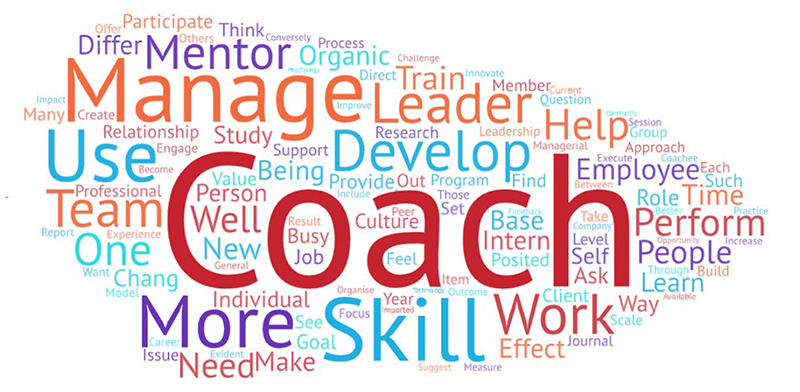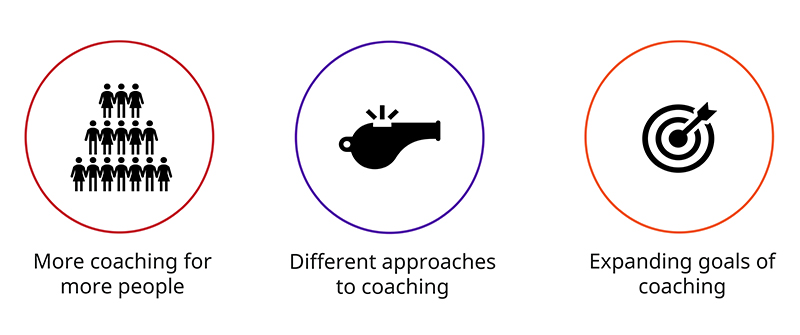Future of Coaching: What is it, what’s it for, and when does it end?
September 14th, 2021
As part of our research on coaching, we invited leaders to participate in a roundtable on the future of coaching. The conversation focused on 4 main topics:
- Increasing access: How can coaching increase access to learning throughout the org (beyond top leadership)?
- Expanding the meaning of “coach”: How are orgs leveraging different types of internal coaches (e.g., manager as coach, peer coaching, reverse coaching)?
- Improving well-being: How can coaching support the whole employee beyond role performance?
- Coaching culture: How can coaching become more systemic?
Shared Initial Research Findings
To start the conversation, we shared our research findings thus far from engaging in ongoing conversations with leaders and conducting an extensive literature review based on 60 articles, blogs, and academic papers.

Figure 1: Future of Coaching Lit Review Word Cloud | Source: RedThread Research, 2021.
The word cloud above, produced by our literature review, points to answering the question, “what is coaching for?”
Org leaders see coaching as a tool to help manage, develop, and mentor employees, improve how they perform, and support them in how they learn and build new skills.
Through this process, we also saw coaching changing in 3 fundamental ways:

Figure 2: Ways Coaching is Changing | Source: RedThread Research, 2021.
- More coaching is being extended to more people in the org past top leadership (e.g., new hires, sales groups, DEIB groups).
- Coaching is starting to shift from a traditional 1:1 between external coach to internal leader to other approaches like coaching on demand, manager as coach, peer coaching, reverse mentoring and coaching, AI coaching, and group coaching.
- The goals of coaching are expanding; while the traditional goal of coaching has been performance, coaching is moving to become a “benefit to the employee” by addressing wellbeing, as nutrition and wellness coaches enter the space.
Key Takeaways
This research set the stage for our conversation. But while we’ve already conducted extensive research over the past 4 months, this roundtable continued to surprise us with some gems and new insights. We learned about the ways orgs are using coaching to achieve some of their most fundamental goals, as well as the ways they’re struggling with the scope and scale of their efforts. Here are our 5 key takeaways:
- Coaching is a tool, profession, and way of life, depending on the context
- Coaching needs a problem to solve
- Coaching shouldn’t blur lines with therapy
- Coaching is one tool in a manager’s toolkit
- Coaching culture is best lived out in practice
Coaching is a tool, profession, and way of life, depending on the context
We asked, “what is coaching?” expecting to hear answers that could be synthesized into one definition, but we discovered that leaders define coaching in different ways for different contexts.
Some leaders saw coaching as a tool for managers: a tool to help their team members learn, grow, and develop key skills. Others referred to coaching as a profession—one that requires some form of accreditation or certification.
And some talked about coaching as something bigger: a framework, perspective, or way of life. These leaders said coaching is what defines good leadership. It’s a lens through which great leaders view all their work, not something they do on occasion. As one leader said:
When coaching is viewed as a leadership style, learning becomes integrated into day-to-day interactions. This makes coaching—and learning—a way of life.
Coaching needs a problem to solve
Leaders talked at length about the difficulty orgs can have in deciding—and communicating to employees—how long coaching efforts should last.
One leader said their org limited coaching engagements to 6 months due to high demand. Participants enjoyed the process so much that they wanted to continue indefinitely. The org needed to determine a cutoff point to allow others to benefit from the coaches’ time.
Others emphasized the importance of clearly setting the coaching agenda and goals at the outset—whether individual or organizational—so it is clear when those goals have been reached. One leader noted:
Coaching is often treated like a silver bullet, but we’re not answering the question, “What’s the problem we’re solving for?” Everything should flow out of the problem to solve.
We were excited to hear about a new example of coaching: integrating it into an org transformation, such as an agile transformation. It’s easier to know when coaching should end in this instance because there is a specific purpose and a problem that it is aiming to solve (e.g., employees learning how to work in an agile framework).
Coaching shouldn’t blur lines with therapy
As we talked about the introduction of well-being into the coaching space, there was some concern that these two worlds are starting to overlap.
Many leaders noted that orgs, as a legal matter, do not provide coaches to discuss personal mental health or medical issues. One leader shared that at their org, employees were referred to therapists for mental health and reimbursed separately, as opposed to integrating that offering into their coaching practice.
However, leaders emphasized employees’ need for human connection—a need that has grown throughout the pandemic. They pointed to team coaching and other group coaching options as ways orgs can help employees connect with one another, find community, and be themselves in a safe space. As one leader said:
Employees need to bring their whole selves to work. The current moment requires it.
These options were seen as more appropriate ways for orgs to support employee well-being while leaving clinical and mental health matters to the licensed professionals.
Coaching is one tool in a manager’s toolkit
When we asked about how coaching is expanding, one of the most common ideas that leaders brought up was “manager as coach.”
Participants stressed the importance of managers having strong coaching skills. Great managers are skilled, for example, in providing good feedback, skillful questioning, setting goals, and guiding employees to think through challenges and come to conclusions.
However, there was also an emphasis on not over-relying on coaching as the only tool for managers: Coaching is not always the right tool for the job. Sometimes managers must direct employees; other times, they may need to act as core team members.
As a result, helping managers understand when and how to effectively use coaching skills is a crucial piece of the “manager as coach” approach. As one leader said:
Before coaching, managers need to know how to assess the situation. What does this person need? What tools do I have at my disposal? What tool should I use based on what’s going on with this person?
Coaching culture is best lived out in practice
Lastly, leaders discussed “coaching culture”—a current buzz phrase—and what it means in practice. Most leaders felt that having a coaching culture means coaching is “in the water” of the org—it’s part of everyday interactions. How to get coaching into the water is, of course, the challenge.
When we asked what orgs are doing to put coaching in the water, they mentioned the following ideas:
- Creating forums that allow people to connect, practice, and experience coaching with one another
- Including coaching in leadership development offerings
- Incorporating coaching into performance conversations
- Following any coaching workshops or training with support and sustainment efforts once employees return to their day jobs
- Expanding access to coaching so that everyone in the org can experience it—to eliminate the disconnect between theory and application, between head and heart. As one leader said:
It’s necessary to experience coaching in order to know what it is and enjoy it.
Expanding access can have a ripple effect, since those who experience and enjoy coaching go on to further support this learning-centric practice and thus influence the culture.
This discussion about how coaching is changing brought up significant insights as well as surprises. Thanks again to those who attended and made it such an enriching conversation. As always, we welcome your suggestions, thoughts, and feedback at [email protected].
Heather Gilmartin Adams
